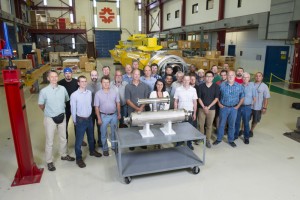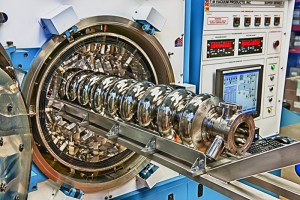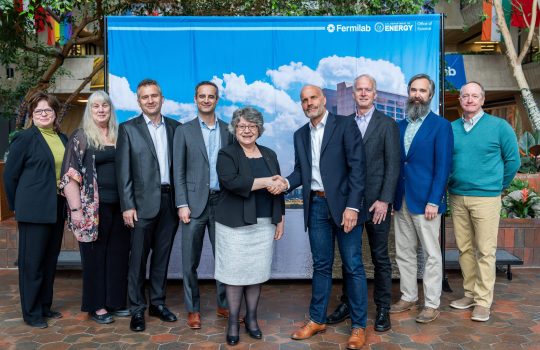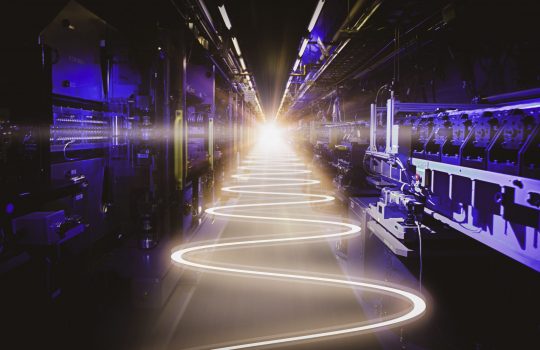
A Technical Division team rallies around a dressed cavity from the LCLS-II project. Photo: Reidar Hahn
Members of Fermilab’s Technical Division are working on superconducting radio-frequency cavities that are shaped like squatty beads on straight string. These prone, uniformly bulging tubes accelerate the particle beams that shoot through their hollow insides. The team recently achieved a record-high quality factor with a fully dressed cavity for a SLAC-headed project, Linac Coherent Light Source II.
“This has taken a lot of hard work from a very dedicated crew,” said Rich Stanek, Fermilab LCLS-II senior team leader. Stanek acknowledged the entire cavity dressing team and all of the SRF scientists that helped reach this record quality factor.
Quality factor, Q, is a measure of how efficient a particle acceleration cavity is. A higher Q means a cavity is losing less energy, which is more cost-effective.
The two LCLS-II free-electron lasers will produce X-rays to probe a wide variety of materials, exotic and otherwise, at the nanoscale. Fermilab is responsible for designing, developing, building and testing about 150 nine-cell cavities for the LCLS-II superconducting accelerator. The R&D process began one and a half years ago. It includes ensuring that the cavities meet certain Q values during testing.
“This is the first integrated test we did,” said Nikolay Solyak, project support group leader. In an integrated test, everything is checked under real conditions. “The conditions were very close to the cavity’s final condition in a cryomodule.”
In this integrated test, the fully dressed 1.3-gigahertz cavity’s quality factor was 3.1 x 1010 at 2 Kelvin and at a 16-megavolt-per-meter peak surface electric field. This Q exceeds LCLS-II’s goal of 2.7 x 1010 and far surpasses current state-of-the-art standards.

An LCLS-II-type accelerator cavity prepares to be treated with nitrogen, a process that increases the cavity’s quality factor. Fermilab recently reported a record quality factor for LCLS-II-type cavities. Photo: Reidar Hahn
“This quality factor is an extremely important step,” said Slava Yakovlev, SRF department head. “It’s a victory.”
SLAC physicist Marc Ross, LCLS-II cryogenics systems manager, says he’s pleased with the results.
“It’s definitely a victory,” Ross said. “These are some of the highest-quality-factor practical resonators ever built.”
A fully dressed cavity is outfitted with all the components it will wear in the LCLS-II accelerator. This includes a titanium jacket filled with liquid helium chilled to 2 Kelvin, a temperature at which niobium is superconducting. It’s also furnished with power-providing couplers, cavity-squeezing tuners to control frequency, and magnetic shielding. These components add heat and can lower Q, so the team had to develop a way to carry this heat away and keep Q high.
“This record Q is really the sum, the final point, of many years of research,” said Anna Grassellino, Fermi’s Technical Division scientist who leads cavity testing and processing for LCLS-II. “It’s really a miracle of science and technology and engineering coming together and producing an unprecedented quality factor. It opens up a way for machines to operate much more efficiently at a much lower cost.”
Grassellino led the Fermilab effort to apply the breakthrough technology, dubbed nitrogen doping, that helped achieve this record Q. It involves infusing nitrogen into a cavity’s inner niobium surface. Nitrogen doping and other Fermilab discoveries that led to this Q value, such as the removal of magnetic flux through rapid cooling, will become new standards for achieving highly efficient accelerators worldwide.
“This is a critical milestone not only in LCLS-II design, but in other modern accelerator projects including our own project, PIP-II,” Yakovlev said.
But there’s more to be done for LCLS-II.
“We still need to show that the full cryomodule with eight cavities meets specifications,” Grassellino said. “There’s always a next step.”



